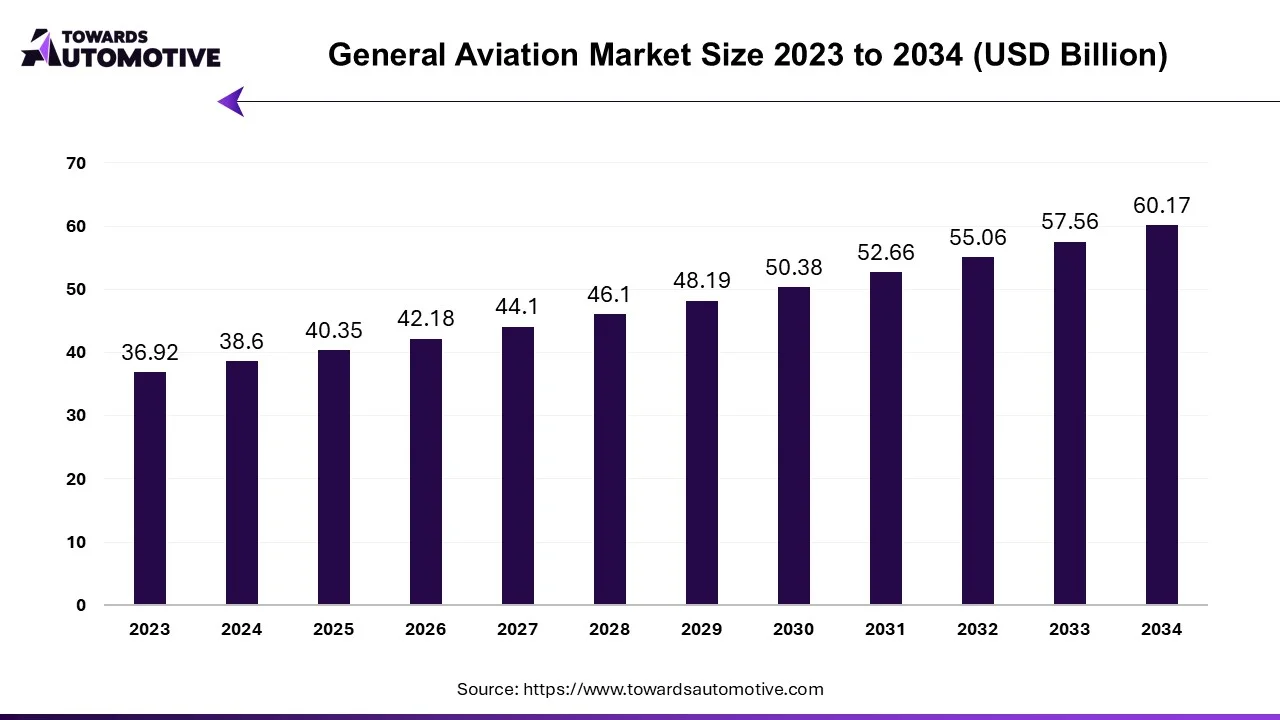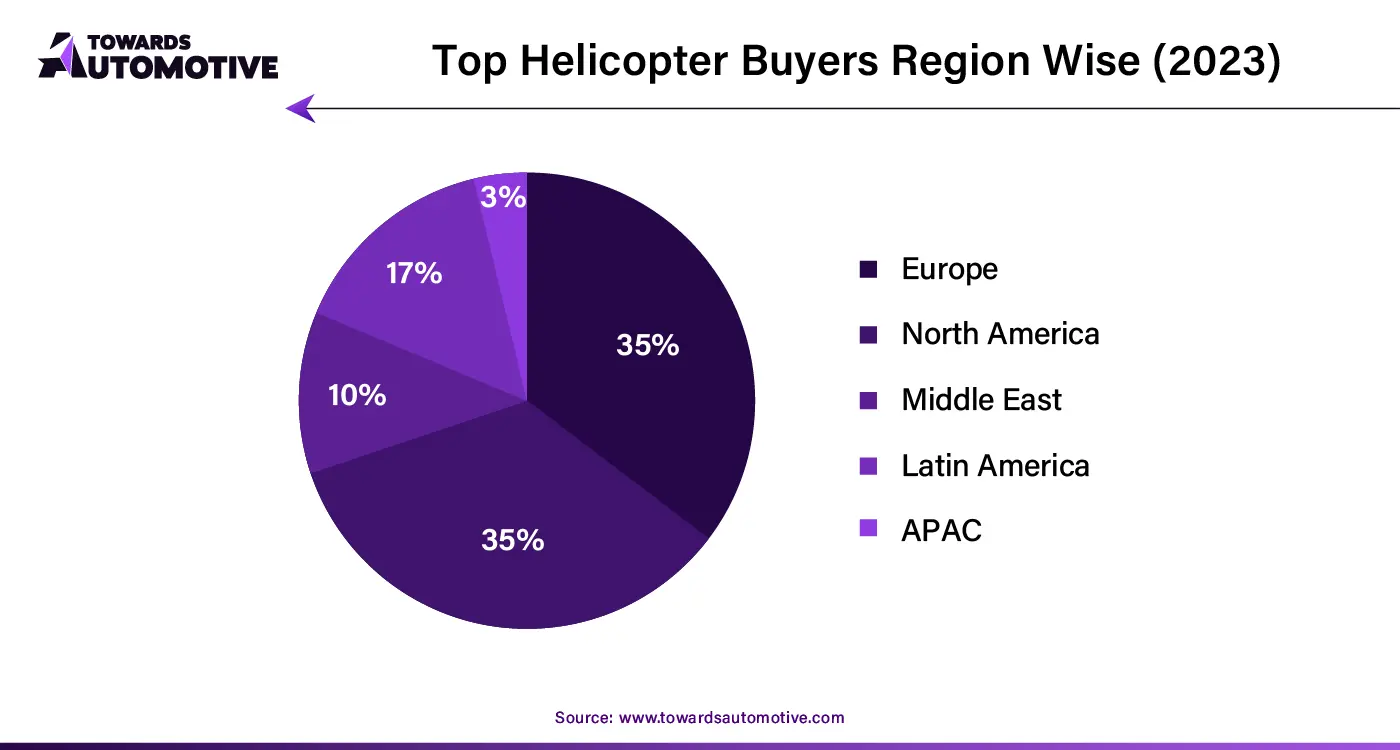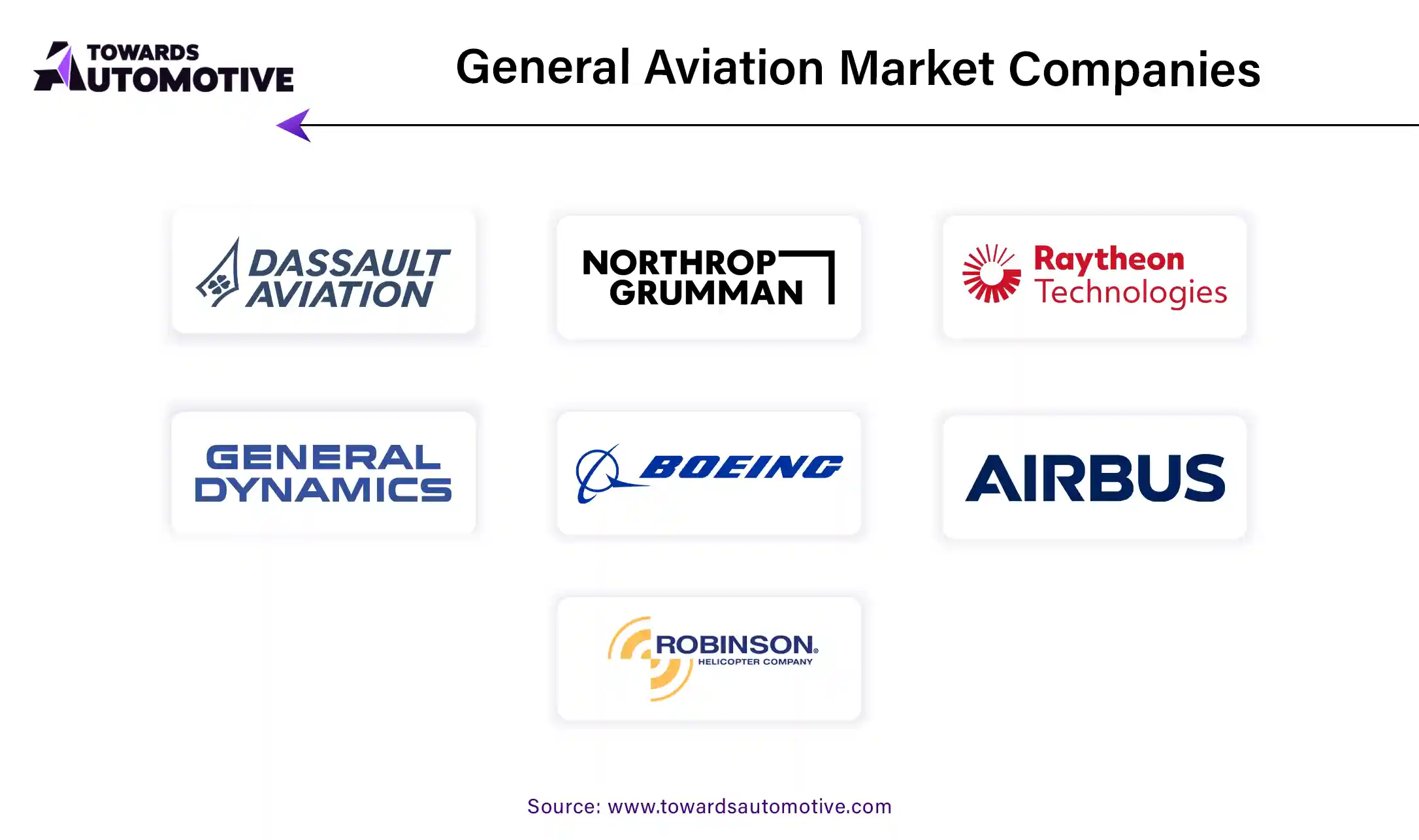March 2025
The general aviation market size is calculated at USD 38.6 billion in 2024 and is anticipated to reach around USD 60.17 billion by 2034, growing at a CAGR of 4.54% from 2025 to 2034.

Unlock Infinite Advantages: Subscribe to Annual Membership
The general aviation market is a significant and rapidly growing segment within the global aviation industry, encompassing all civilian aircraft operations other than scheduled air services. General aviation includes a broad range of activities such as recreational flying, flight training, business aviation, air ambulance services, and cargo transport. It plays a vital role in connecting remote areas, providing flexible travel options, and supporting a variety of industries with specialized air services. The market is driven by factors such as the increasing demand for private and business jet travel, advancements in aircraft technology, and rising disposable incomes in emerging economies. Additionally, the growing preference for faster and more convenient travel options, particularly in regions with limited commercial airline services, contributes to the expansion of general aviation.
As business aviation continues to grow, companies are increasingly adopting private aircraft to reduce travel time and enhance productivity. Furthermore, technological innovations, including the development of more fuel-efficient aircraft, advanced avionics systems, and electric aircraft, are driving the evolution of the general aviation market. The increasing focus on reducing carbon emissions and improving operational efficiency is also influencing the design and production of general aviation aircraft. With the expansion of airports, improved infrastructure, and rising awareness of the benefits of general aviation, the market is poised for continued growth, providing significant opportunities for manufacturers, service providers, and aviation enthusiasts.
AI is playing an increasingly vital role in the general aviation market by enhancing aircraft performance, safety, and operational efficiency. Its integration into aviation systems is driving significant advancements across multiple aspects of general aviation, including flight operations, maintenance, and passenger experience.
AI-powered systems are improving the safety of general aviation by enhancing navigation, collision avoidance, and weather prediction. AI can process vast amounts of real-time data from various sensors and sources to predict potential hazards, adjust flight paths, and provide early warnings to pilots about changes in weather or obstacles, helping to reduce the risk of accidents.
AI is transforming aircraft maintenance by using machine learning algorithms to analyze data from sensors and historical maintenance records. This predictive maintenance technology allows aircraft operators to anticipate equipment failures before they happen, reducing downtime and maintenance costs. By identifying potential issues early, AI can ensure better aircraft reliability and lower the risk of unplanned repairs.
AI is also driving the development of autonomous flight capabilities, which could potentially transform general aviation. With advancements in AI and machine learning, there is growing interest in autonomous or semi-autonomous aircraft, where AI systems could handle aspects of flight, reducing the workload for pilots and enhancing operational efficiency.
AI is improving the passenger experience by providing personalized services, from optimized scheduling and routing to automated check-ins. Additionally, AI-powered chatbots and customer service platforms are enhancing communication between airlines, passengers, and service providers, ensuring more efficient and streamlined operations.
Growing investment in the aviation sector is a significant driver of the general aviation market, as it fosters technological innovation, expands infrastructure, and increases overall market accessibility. Increased funding from both private investors and government agencies has spurred the development of new, more efficient aircraft, advanced avionics, and innovative safety systems, making general aviation more appealing to a broader audience. Investments in sustainable aviation technologies such as electric aircraft and hybrid propulsion systems, are also gaining momentum, addressing environmental concerns and attracting environmentally conscious consumers.
Moreover, substantial investments in airport infrastructure—such as the expansion of smaller regional airports, improvements in hangars and maintenance facilities, and the development of dedicated terminals for general aviation—are enhancing the accessibility and convenience of private flying. These infrastructure advancements not only make general aviation more viable for a wider range of users but also help reduce congestion at commercial airports, improving overall efficiency.
Additionally, as more capital flows into the sector, new services such as air taxis, on-demand charter flights, and unmanned aerial vehicle (UAV) operations are emerging, further expanding the scope of the general aviation market. With investments driving innovation, accessibility, and efficiency, the general aviation market is poised for sustained growth, meeting the rising demand for flexible, cost-effective, and sustainable air travel options across various sectors.
The general aviation market faces several restraints that could hinder its growth. High operational and maintenance costs, including fuel expenses, insurance, and aircraft upkeep, limit accessibility for many potential users. Additionally, regulatory challenges, such as strict aviation safety standards and airspace restrictions, can increase operational complexities for general aviation operators. Moreover, the shortage of qualified pilots and technicians, coupled with the high costs of pilot training, presents a challenge to market expansion. Economic fluctuations and environmental concerns related to emissions may also impact the demand for general aviation services.
The growing demand for autonomous aircraft is creating significant opportunities in the general aviation market by driving innovation and expanding the range of services offered. Autonomous aircraft, which rely on advanced technologies like artificial intelligence (AI), machine learning, and automation systems, have the potential to reduce the need for skilled pilots, lower operational costs, and increase efficiency. As autonomous systems become more reliable, they can offer a safer and more cost-effective alternative to traditional piloted aircraft, attracting both business and recreational users.
One key area where autonomous aircraft are expected to have a major impact is in air taxis and on-demand air transportation. These services can be offered more affordably and frequently, making air travel more accessible to a broader audience. Additionally, the reduced need for pilots could lead to lower labor costs, making general aviation services more economically viable for operators and passengers alike.
Furthermore, autonomous aircraft can improve operational safety by reducing human error, which is a leading cause of aviation accidents. The implementation of autonomous systems can lead to more precise flight operations, better fuel efficiency, and enhanced maintenance capabilities through predictive analytics. As the technology continues to mature, the growing demand for autonomous aircraft is expected to open new markets, enhance existing services, and drive the overall growth of the general aviation industry in the upcoming years.
The piston fixed-wing aircraft segment held a dominant share of the market. The piston fixed-wing aircraft segment plays a crucial role in driving the growth of the general aviation market due to its affordability, versatility, and wide range of applications. Piston aircraft, which are typically powered by internal combustion engines, offer an entry point into private aviation for both recreational and business users. Their lower operational costs compared to turbine-powered aircraft make them an attractive option for flight schools, private pilots, and small business owners looking to invest in aviation without the hefty financial commitment required for more advanced aircraft.
These aircraft are widely used for flight training, as they are easier to operate and maintain, providing an ideal platform for new pilots. Additionally, their popularity in the recreational flying community is growing as more individuals seek the freedom and flexibility offered by personal aircraft. Piston fixed-wing aircraft are also widely used in agricultural, surveying, and aerial photography applications, further broadening their appeal in the general aviation sector.
Technological advancements in piston aircraft, such as improved avionics, fuel efficiency, and safety features, are enhancing their value proposition. These advancements not only make the aircraft more reliable and cost-effective but also increase their accessibility for a wider range of consumers. As a result, the piston fixed-wing aircraft segment continues to contribute significantly to the overall growth of the general aviation market, meeting the needs of both commercial and recreational aviators.
The helicopters segment is expected to grow with a notable rate during the forecast period. The helicopters segment is a significant driver of growth in the general aviation market, primarily due to their versatility, ability to access remote or hard-to-reach areas, and increasing demand across various sectors. Helicopters are particularly valued for their ability to take off and land vertically, which allows them to operate in locations without the need for traditional runways, making them essential for operations in urban environments, mountainous regions, offshore oil rigs, and areas with limited infrastructure. This capability has expanded the use of helicopters for a wide array of applications, including emergency medical services (EMS), air tourism, corporate transport, and law enforcement, contributing to the overall market growth.
The demand for air ambulance services is one of the key factors driving the helicopter segment, as these aircraft are crucial for providing rapid medical transport in critical situations. Helicopters are also heavily utilized for search and rescue operations, firefighting, and military applications, further supporting their continued use in general aviation. In addition to these essential roles, the rise of helicopter tours, which allow passengers to explore popular tourist destinations from the air, is boosting the demand for civilian helicopters in the leisure sector.
Advancements in helicopter technology, such as improvements in fuel efficiency, reduced operating costs, and enhanced safety features, have also increased their attractiveness to operators, further driving growth in this segment. As a result, the helicopter segment continues to be a key contributor to the expanding general aviation market.

North America dominated the general aviation market. The general aviation market in North America is experiencing robust growth driven by several key factors, including the rising demand for private and business aviation, the growth of air ambulance services, and the expansion of aviation infrastructure. The increasing demand for private and business aviation is fueled by the need for more efficient and flexible travel options. Business executives and high-net-worth individuals are turning to private aircraft for time-sensitive meetings, reducing travel time, and avoiding the congestion of commercial airports. This demand is further supported by advancements in aircraft technology, offering more affordable and fuel-efficient options for private and business aviation.
The growth of air ambulance services is another significant driver of the general aviation market in North America. As healthcare systems become increasingly focused on providing rapid medical response and emergency care, air ambulance services play a crucial role in transporting critically ill patients, especially in remote or underserved regions. This increased need for air medical transport has led to greater demand for specialized aircraft and services within the general aviation sector.
Furthermore, the expansion of aviation infrastructure, including improved airports, modern terminals, and increased hangar space, is providing better accessibility for general aviation operators and users. The development of smaller regional airports and improved connections between major cities further supports the growth of private aviation and air services, fostering a favorable environment for the general aviation market in North America. Thus, these factors are contributing to the continued growth and evolution of the market.
Europe is expected to grow with the highest CAGR during the forecast period. The general aviation market in Europe is experiencing significant growth driven by the expansion of air charter services, increased interest in recreational flying, and technological advancements in aircraft and avionics. The expansion of air charter services has played a key role in the growth of general aviation, as more businesses and individuals seek flexible and time-saving travel options. Charter flights offer tailored schedules, convenience, and direct access to regional airports, bypassing the need for commercial air travel, which is becoming an increasingly attractive option for both business and leisure travelers.
Additionally, the rising interest in recreational flying is fueling market growth as more individuals seek the freedom and flexibility of private aviation. As disposable incomes rise and aviation becomes more accessible, flight schools and private aviation clubs are seeing an increase in the number of people learning to fly for personal enjoyment, further driving demand for light aircraft and flying services. This trend is particularly prevalent in countries like the UK, France, and Germany, where recreational flying has a long-standing tradition.
Technological advancements in aircraft and avionics are also contributing to the expansion of the general aviation market. The development of more fuel-efficient, cost-effective, and environmentally friendly aircraft, along with innovations in advanced avionics systems, is enhancing the safety, performance, and affordability of general aviation. These technological improvements make private flying more accessible and attractive to a broader range of consumers, thus driving the overall growth of the general aviation market in Europe.

By Type
By Region
March 2025
February 2025
February 2025
January 2025
We offer automotive expertise for market projections and customizable research, adaptable to diverse strategic approaches.
Contact Us